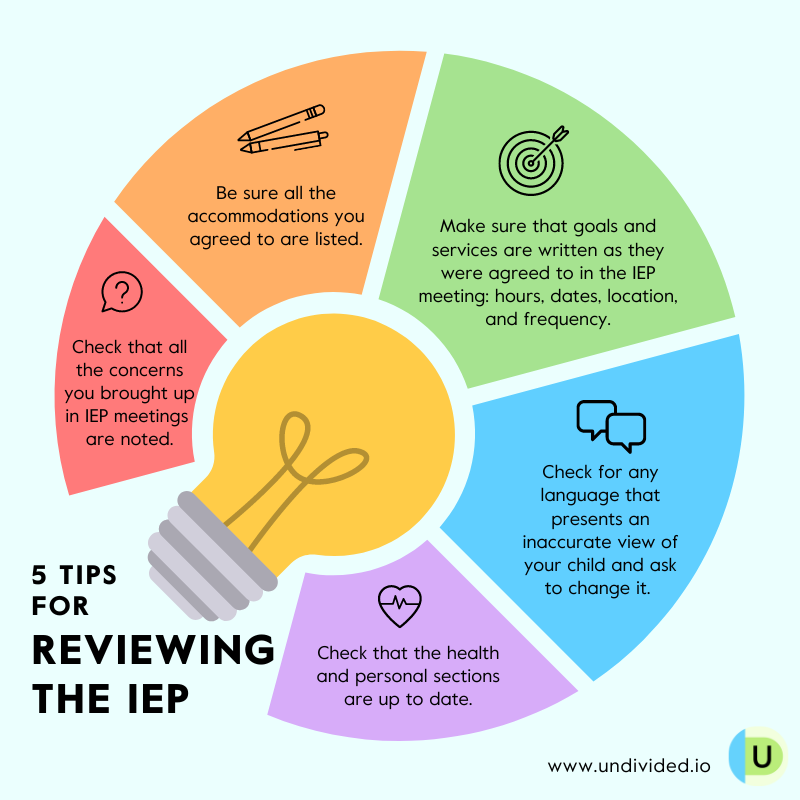The Fall Check-In: Following Up with an IEP at the Beginning of the New School Year
You’ve signed the IEP that’s currently in place — but is your child actually getting everything that has been written into it? With school in full swing, it’s important to make sure your kid is receiving the services and supports they need to make meaningful progress and get their year off to a great start.
About four to six weeks after school begins, make time to review some key areas of your child’s IEP to see what may need updating or adjusting. This can help you take note and check-in with your IEP team to communicate what’s not being implemented. It can also help you determine whether you'll need to call a fall check-in meeting with your IEP team (if, after the check-ins, you want to update the IEP).
Should you call an IEP meeting at the beginning of the school year?
While an IEP meeting isn’t necessary for everyone, it can be critical if:
- You want to make changes to the IEP.
- Your child is starting the year at a new school and you want to meet the IEP team to establish a good working relationship and build trust — and make the kinds of adjustments that inevitably come with a change in schools.
- Your child will be working with therapists, teachers, or administrators who aren’t familiar with them. Discussing last year’s goals — especially if your child didn’t make the progress the team had hoped for — can help establish better expectations for this year.
Even if those situations don’t apply to you, it’s still a good idea to check in on your child’s IEP for the year and see if it needs any updating.
Review your child’s IEP
Spend some time reviewing your child’s IEP the way you would before signing it. Check out our article How to Make Sure Your IEP Is Being Followed for a breakdown of how to make sure your child’s teachers and school are providing everything they agreed to. Focus on the most important parts of the IEP: pay special attention to the list of accommodations/modifications as well as the related services. Are they providing everything your child needs for the new school year? If not, request an IEP meeting to make updates. Remember that if your child has missed services, then they are entitled to makeups, and if something else wasn't implemented correctly, they may be entitled to comp ed.

Request any necessary assessments
If your child has experienced a loss of learning over the summer or you feel their goals, services, and accommodations are no longer sufficient, a new assessment could go a long way toward getting your child the supports they need.
One reason you may want an updated assessment is to check in on the tools (whether high- or low-tech) that your child uses to access their education. Are they able to keep up with the pace of classwork? Are they struggling to do work independently at school or at home? Could a few well-designed apps make reading and writing assignments easier so they can focus on the learning at hand? Read about all the ways that assistive technology (AT) can boost a child’s access to their education, and why it’s important to check in on their accessibility needs every year. (You can also check out our article Assistive Technology Tools to Empower Students with Disabilities for a round-up of the many assistive tech tools and software applications out there.)
Finally, remember that parents can request an assessment of their child at any time. Check out our article on assessments to learn more. If you're an Undivided member, see this sample letter to help you request an assessment.
Review your child’s goals and make sure they’re based on the state standards
There are so many reasons why it’s important to make sure your child’s IEP goals are based on the state standards. The main one, of course, is that every child deserves a rigorous education that helps them grow and learn about the world.
In the majority of states, teachers use the Common Core State Standards to shape what they teach at each grade level. When students aren’t ready to access the standards as written, teachers also have access to Core Content Connectors (CCC) and Essential Understandings (EU), which help bridge the gap for both children with disabilities and their typically developing peers. Check out these resources to help you talk to your child’s teacher about using CCC and EU to support your child if they need better access to Common Core curriculum.
Every child also deserves the opportunity to graduate with a diploma. Recent developments in California have led to the creation of a new pathway to earning a diploma for students with cognitive disabilities. Even if a student is using modifications to access their curriculum, or taking alternate assessments, they have the right to the opportunity to work toward a high school diploma.
Checking to make sure your child is included with peers during their school day is one of the biggest reasons to do a fall check-in. If you wrote an inclusive placement or inclusive goals into your child’s IEP, you’ll want to ensure that the school staff is working to make sure your child is meaningfully included in the classroom.
Placement
- Are they getting the educational and/or social minutes with their same-aged peers that are outlined in their IEP?
- If your child is in a special day class for the majority of the day, where do they sit when they go into the gen ed classroom? Do they have their own desk? Are they interacting with other kids or just other adults? Are kids with IEPs truly included in the same activities at the same time in the same place with general education students?
- Are all gen ed class activities accessible and inclusive? This includes group work, independent work time, presentations, performances, asking/answering questions, and student responsibilities.
Accommodations/modifications
- Is your child able to relay their knowledge in an accessible way for THEM, or are they expected to do things the same way as everyone else?
- If a specialist or special education teacher is modifying work for teachers and your child, can you see samples, and is that happening every day?
Social opportunities
- Does your child eat lunch, go on field trips, and have PE with same-aged peers?
- Do they have daily opportunities to socialize with all kids?
- If your child requires facilitation for socializing or communicating, who is supporting that?
The beginning of the school year is also a good time to help your child get involved in extracurricular and social activities that are just starting up. Check out our article on socialization and inclusion for ideas around lunch clubs, recreation therapy, and more, as well as this primer on extracurricular rights to see what IEP services your child should have outside the classroom.
Make sure there’s an emergency plan for your child
Often, students with disabilities are overlooked when it comes to emergency planning, and too often, the school’s plan is not realistic or actually designed to keep your child safe. It’s essential to discuss an emergency plan with your IEP team to make sure your child’s support and mobility needs are fully accounted for, including scheduling time to practice implementing the plan. Check out our article about emergency plans for detailed information about how to get started, resources to help you work with your IEP team, and tips from special education and school safety experts.
You should also make sure any health-related plans are covered in your child's IEP, such as what to do in a medical emergency. See our article on Individualized Health Plans for more information.
Update the IEP as needed
Remember, you can call an IEP meeting at any time. If, after your check-ins, you realize that you need to update your child’s IEP, you can request a meeting. If you have a fall IEP meeting coming up, our Ultimate Checklist for IEP Prep has you covered to help you get ready.
If you’re thinking this sounds like a lot of things to get in place at the beginning of the school year, you’re not wrong! That’s why Undivided is here to help with making sure all these tasks get done. As parents, we know all the hoops we have to jump through to ensure that our kids get the most out of their education, so we've loaded the Undivided platform with digital tools to help with the whole IEP process and more. Plus, experienced Navigators are available to provide 1:1 guidance any time you need more help. If you’re not already an Undivided member, join today to build a Roadmap focused on your family's needs and goals, and get help advocating for your child at school.
Ensure my child's Individualized Education Program (IEP) is being followed
Join for free
Save your favorite resources and access a custom Roadmap.
Get StartedAuthor




